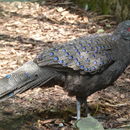Biology
provided by Arkive
In captivity, Germain's peacock-pheasant appears to breed almost year-round, with females laying again once their young become independent. In the wild, this bird has been observed breeding from February to April. Clutches usually consists of two eggs, which are incubated for 21 to 22 days (6).
Nothing is known of the diet in the wild, although it is probably similar to that of the grey peacock-pheasant (Polyplectron bicalcaratum), with which this species shares its range (6). This consists of berries, fruits, seeds, wild figs, grubs, ants, insects, snails and other small animals (2).
Conservation
provided by Arkive
Populations survive in several protected areas within Vietnam, and there are records from Seima Biodiversity Conservation Area and Virachey National Park in Cambodia. However, a shortage of staff and resources in some of these areas means that hunting, disturbance and small-scale logging persist. A five year project, started in 1998, has now been completed in Cat Loc Nature Reserve and Cat Tien National Park (the two areas are now administratively integrated), which focused on research towards a conservation management plan, capacity building, community development and conservation education. Alongside such important initiatives, it is imperative that more effective control of human encroachment and hunting is achieved in protected areas, if this graceful pheasant is to survive growing human pressures (7).
Description
provided by Arkive
Like most other peacock-pheasants (Polyplectron spp.), this is an elegant species possessing sombre colours but elaborate markings. The male's plumage is dark brown to black, finely spotted with buff, and decorated on the back, shoulders, wings and tail with large round eye-shaped spots (ocelli), which are brilliant metallic violet-blue and green in colour (4). Males can be distinguished from other peacock-pheasants (Polyplectron spp.) by the larger size of these eye-shaped spots and the lack of a crest or ruff around the neck (2). Females are smaller and slightly duller than males, with dark brown plumage streaked and freckled with pale brownish-grey, and the blue eye-shaped spots on their back, shoulders and wings are somewhat triangular (2) (4). Both sexes have bare red facial skin around their eyes (5).
Habitat
provided by Arkive
Found in a range of forest types including lowland, montane, dipterocarp-dominated evergreen and semi-evergreen forest, as well as logged secondary forest, and also recorded from thorny bamboo brakes (2) (7). Known from sea-level up to at least 1,400 metres above sea level (7).
Range
provided by Arkive
Known from central and southern Vietnam and eastern Cambodia (6).
Status
provided by Arkive
Classified as Near Threatened (NT) on the IUCN Red List 2007 (1) and listed on Appendix II of CITES (3).
Threats
provided by Arkive
Historically, Germain's peacock-pheasant has suffered major declines due to forest clearance for subsistence cultivation and localised commercial cropping of coffee and cashew nuts, as well as commercial logging and resettlement programmes (6) (7). Much of the lowland forest within the species' range has been destroyed or severely fragmented, and hill forest is being increasingly logged and disturbed (8). Hunting with guns and snares, even within protected areas, is also a significant threat to this species (7) (8).
Germain's peacock-pheasant
provided by wikipedia EN
Germain's peacock-pheasant (Polyplectron germaini) is a pheasant that is endemic to Indochina. The name commemorates the French colonial army's veterinary surgeon Louis Rodolphe Germain.
Description
The bird is a medium-sized, approximately 60 cm long, brownish dark pheasant with finely spotted buff, short crest, bare red facial skin, brown iris and purplish-blue ocelli on upperbody plumage and half of its tail of twenty feathers. Both sexes are similar. The female has eighteen tail feathers and is smaller than male.
Taxonomy
The phylogeny of this species is somewhat enigmatic. mtDNA cytochrome b and D-loop as well as the nuclear ovomucoid intron G data confirms that it belongs to a clade together with the grey peacock-pheasant, but also the "brown" southernly species bronze-tailed peacock-pheasant and mountain peacock-pheasant. Biogeography suggests that it may indeed be the most ancient form in its clade, speciating parapatrically or peripatrically in Cochinchina (Kimball et al. 2001). This probably took place in the Late Pliocene, roughly 4-3 mya.[3]
Distribution and habitat
The Germain's peacock-pheasant is endemic to southern Indochina. It is found in the seasonal tropical forests of mid-southern Vietnam and far eastern Cambodia; it can be found readily in Cat Tien National Park. The female usually lays two creamy-white eggs.
Status and conservation
Due to ongoing habitat loss and limited range, the Germain's peacock-pheasant is evaluated as Near Threatened on the IUCN Red List of Threatened Species. It is listed on Appendix II of CITES.
References
- Kimball, Rebecca T.; Braun, Edward L.; Ligon, J. David; Lucchini, Vittorio & Randi, Ettore (2001): A molecular phylogeny of the peacock-pheasants (Galliformes: Polyplectron spp.) indicates loss and reduction of ornamental traits and display behaviours. Biol. J. Linn. Soc. 73(2): 187–198. HTML abstract

- license
- cc-by-sa-3.0
- copyright
- Wikipedia authors and editors
Germain's peacock-pheasant: Brief Summary
provided by wikipedia EN
Germain's peacock-pheasant (Polyplectron germaini) is a pheasant that is endemic to Indochina. The name commemorates the French colonial army's veterinary surgeon Louis Rodolphe Germain.
- license
- cc-by-sa-3.0
- copyright
- Wikipedia authors and editors

